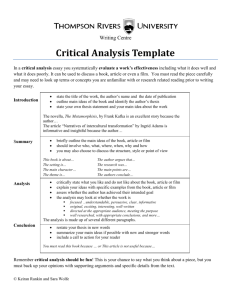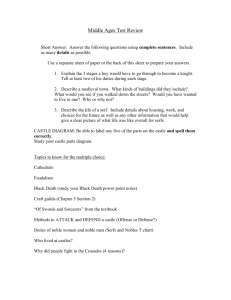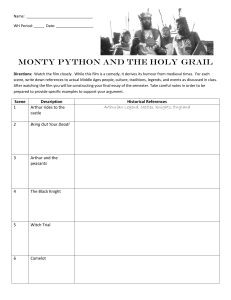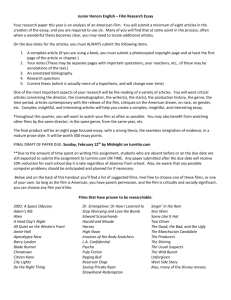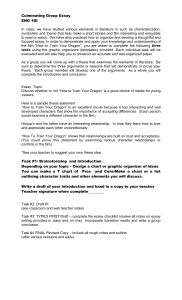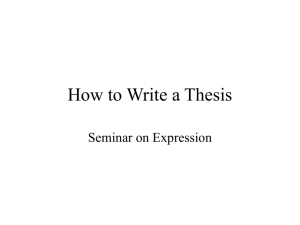How to answer an essay question
advertisement
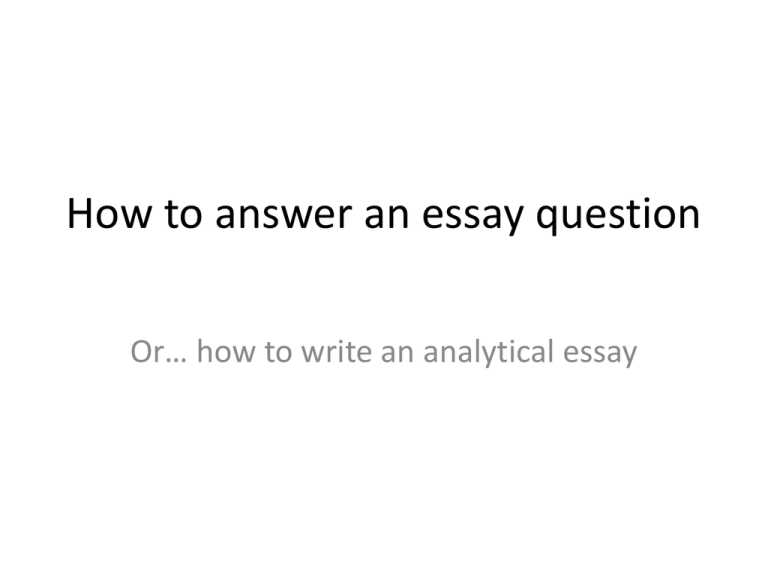
How to answer an essay question Or… how to write an analytical essay STEP ONE! REMIX THE “marking criteria” - RUBRIC __________________________________________________ • demonstrate understanding of a text’s distinctive qualities and how these shape meaning • organise, develop and express ideas using language appropriate to audience, purpose and form ___________________________________________________ demonstrate knowledge and analysis skill in naming and explaining a text’s language forms and features… and how these show the ideas, concerns, characters and events in the text STEP 1 = Remix the rubric: • Understanding = knowledge / interpretation / opinion / point-of view / attitude • The hero = a person who is honest, genuine, and who does the “right thing even when it’s difficult = INTEGRITY • Context = within the limits or expectations of the English course (the subject of English) • Analyse = pull it apart – see how it works • Explain = put it back together and describe in detail how it works • Assess = weigh-up whether or not the techniques / structure actually works well. • The ways = • Ideas = • Represented = The first dot-point of the rubric is the blue-print (map) for the thesis statement of your essay Now… for the essay question… In The Castle, how does the director* represent his perspective about heroes in times of conflict? In your answer, you must name, analyse and explain the effect of specific film and language techniques which are used in The Castle *Rob Stitch • organise, develop and express ideas using language appropriate to audience, purpose and form (2nd dot point from the “marking criteria” rubric) STEP 2 – UNPACK THE QUESTION • HOW = what language/film forms and features • PERSPECTIVE = viewpoint / view / evaluation / opinion / side • HERO = an individual who is honourable, courageous, honest and selfless / leader / “champion” • CONFLICT = difficult situation / war / battle / argument / difference of opinion / struggle / disagreement What is HUMAN CONFLICT? • inner conflict within a person • a difference of opinion between 2 people • a difference of values and beliefs among different groups of people (Govt. and public) • When one person of group challenges another person or group • A violent fight between individuals, groups or countries STEP 3 – REWRITE THE QUESTION IN THE FULL… PLAIN-ENGLISH… VERSION: In The Castle, what film and language techniques does Rob Stitch use to show his views on what it means to be a real hero in a difficult situation. STEP 4 – WRITE THE THESIS STATEMENT THESIS STATEMENT STEP 4 – WRITE THE THESIS STATEMENT Example 1. In The Castle, Rob Stitch (director) uses a variety of film and language techniques to represent his perspective about an ordinary Australian bloke who becomes a real hero in a time of conflict. STEP 5. Check your thesis statement to make sure it “matches” the rubric! __________________________________________ • demonstrate knowledge and analysis skill in naming and explaining a text’s language forms and features… and how these show the ideas, concerns, characters and events in the text _____________________________________ Example 1. In The Castle, Rob Stitch (director) uses a variety of film and language techniques to represent the idea that an ordinary Australian bloke can be a real hero in time of conflict? Essay Question – “The Hero” _______________________________________ In your answer, you will be assessed on how well you: • Express understanding of ideas about “the hero” in the context of your study • Analyse, explain and assess the ways that the ideas about “the hero” are represented in a variety of texts • Organise, develop and express ideas using language appropriate to audience, purpose and form __________________________________________ STEP 2 = Unpack the question How does the film The Castle (by Rob Stitch) support the idea that a hero can be anyone who is truly honest, genuine and selfless? • • • • • • • How = Support = Idea = The hero = Honest = Genuine = Selfless = doesn’t do things just to get attention / doesn’t take all the credit when he wins / fights for what is best for all people – not just him/herself. STEP 3 = Re-write the question in the longest – simplest form… • What film techniques are used in The Castle to show the point-of-view that a person who has heroic qualities can be anyone who is truthful, loyal, not fake and who doesn’t think “it’s all about me”? • Who in the film is a “hero”? • What does he do that is truthful? • What does he do that shows he is not fake? • What does he do that shows it “not all about him”? • Who in the film is a “hero”? Darryl Kerrigan and Mr Hamil • What does he do that is truthful? The scene where he “admits” that a lot of the “features” of his house are actually fake. • What does he do that shows he is not fake? The scene where he refuses to do what the government want him to do. He sticks to his guns and golds onto his beliefs when he refuses to sign the papers to give-up his house. • What does he do that shows it “not all about him”? The scene where Darryl thinks he’s let everyone down. The fianl scene of the celebratory house party when everyone is congratulating Darryl – and he says that it was everyone else… STEP 4 = write a thesis statement STEP 4 = write a thesis statement How do you start your thesis statement? Where do you start? You go back to the question! Use the words in the actual essay question and – use these words (plus your own from your “unpacked” bank of words) and write the answer to the question. Turn this question into a THESIS STATEMENT… How does the film The Castle (by Rob Stitch) support the idea that a hero can be anyone who is truly honest, genuine and selfless? Your THESIS STATEMENT is the “glue” that holds your essay together. If you DON’T keep going-back to your THESIS STATEMENT… you will end up going “off track” and you’ll start “waffling on about the story… instead of analysing the techniques. If you DO keep going back to your THESIS STATEMENT… you’re essay will be well-structured and you will answer the question clearly and accurately. Film techniques used in The Castle • Voice-over narration – – allows the viewer to hear the story from the perspective of the narrator – The audience hears and “takes-on” the opinions and ideas of the narrator Film techniques used in The Castle • Eye-level shots – – Positions the audience to feel like they are on the “same level” as the characters in the film – Creates a realistic feel to the film – which makes the characters seem more realistic and “relatable” • Repetition of internal shots – Dinner table scenes, and “trading post” scenes… creates a sense that the family value these parts of their lives. That family being together in their “castle” is important Film techniques used in The Castle • Language style – – Vernacular: Australian catch-phrases and slang - to show the characters as being working-class Australians – Short simple sentences and one-syllable words: from Darryl and the narrator – to show that the characters say what they mean in a simple and straightforward way. This makes them seem honest – they’re not hiding anything with complex words or sentence structure Film techniques used in The Castle • Costuming – – Casual and mass-produced non-label clothing – to show that the characters are working class – 80’s style hair styles and “stone wash” highwaisted” jeans – to show that narrative is set in the 1980s and that the characters conform to the fashion of the working/middle-class Film techniques used in The Castle • Contrast – • Costuming = the Kerrigans and Mr Danuto Vs the Court staff and Mr Hamil • Mis-en-scene = the “castle” and the High Court • Characters = the different characters who live on the same street (age, gender, race) • Boonydoon Vs The Castle • The “castle” and the gaol
